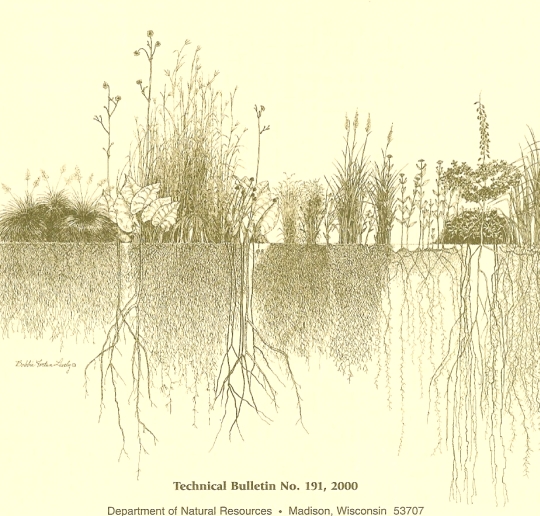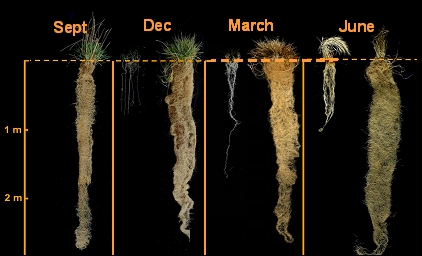I believe improved crop practices are a vital aspect in meeting our cellulosic feedstock needs. There are a few areas that offer significant potential:
- crop rotation,
- the use of polyculture plantations,
- perennials as energy crops, and
- better agronomic practices.
We address all four issues here. Though none of these have been extensively studied, early studies and knowledgeable speculation point to their likely utility. Further study of these techniques is urgently needed, especially the use of grasses or other biomass-optimized winter cover crops.
Crop rotation
I have proposed the usage of a 10 year x 10 year energy and row crop rotation. As row crops are grown in the usual corn/soy rotation, lands lose topsoil and get degraded, need increased fertilizer and water inputs, and decline in biodiversity. By growing no-till, deep-rooted perennial energy crops (like miscanthus or switchgrass — see below) for ten years following a ten year row crop cycle, the carbon content of the soil and its biodiversity can be improved and the needs for inputs decreased. The land can then be returned to row crop cultivation after ten years of no-till energy crops.
Currently unusable degraded lands may even be reclaimed for agriculture using these techniques over a few decades. A University of North Dakota study highlights some of the benefits for food crops. I expect similar or even greater benefits for food crop/energy crop long cycle rotations, especially in soil carbon content:
- Improved yields: a crop grown in rotation with other crops will show significantly higher yields than a crop grown continuously.
- Disease control: changing environmental conditions (by changing crops) changes the effect of various diseases that may set in with an individual crop, and crop rotation can limit (and often eliminate) diseases that affect a specific crop.
- Soil nitrogen: legumes (or other nitrogen-fixing crops) used as part of a rotation help to restore the nitrogen that has been depleted by previous crop harvests allow a field to remain fertile for longer periods. Energy crops in the rotation can increase soil carbon content and reduce the impact of topsoil loss materially.
- Better land: the study notes that farmers practicing crop rotations comment on improvements in soil stability and friability. In addition, crop rotations have the potential to increase the efficiency of water usage (by rotation deep-rooted and more moderately rooted crops, or rotation of perennials in long cycles with row crops).
One aspect of the crop-rotation approach is utilizing cover crops such as grasses, legumes, or small grains that are grown between regular crop production periods (i.e., winter for most crops, and summer for winter-specific crops such as winter wheat). As Part I details, Professor David Bransby has noted that such crops require no additional irrigation, and use about 30 percent of the fertilizer of regular crops like corn. Elsewhere, Professor Greg Roth at Penn State is studying the usage of specific winter cover crops (like hulless barley) and has noted it could be used to increase biofuel yields per acre.
In communication, Professor Roth notes:
One factor to consider for future research and thinking in this area is that winter cover crop yields are increased with earlier planting, especially in northern states. Planting is often delayed because we are waiting for the primary crop to dry down. If the primary crop can be harvested just after physiological maturity, then yield of both the primary and winter cover crops can be maximized.
He further noted that the system as a whole provides an excellent living ground cover.
In addition to providing biomass, winter cover crops provide the benefits of crop rotation — adding organic matter to the soil, recycling nutrients, and more efficient usage of soil and water resources. Further study of these winter cover crops as a potential biomass source is needed, but they could provide a significant portion of our biofuel land needs while improving the land’s ecology over just planting row crops and leaving the land unused during the winter. This will also improve row crop agriculture during the summer. It is even possible that winter cover crops could eliminate the need for most additional lands to meet our biofuels needs in the U.S.
Use of polyculture plantations
Another important crop practice is the idea of utilizing polyculture species instead of monocultures. This is particularly possible for energy crops, as many processes can accept a mixture of biomass types. The Land Institute notes that polycultures (and the resulting plant diversity) have significant benefits, from the provision of an “internal supply of nitrogen, management of exotic and other harmful organisms, soil biodiversity, and overall resilience of the system.” Further research shows that grasslands that suffer from overgrazing or drought tend to recover faster if there is greater biodiversity.
The Australian Rural Industries Research and Development Corporation notes (PDF) that “polyculture is shown to offer the proverbial ‘free lunch’ by producing more from less.” The report goes on to note that polycultures yield in greater amounts from smaller areas, and their yields are generally more stable than monocultures (with regards to income level and general risk). Furthermore, polycultures were found to be more efficient in gathering resources such as light, water, and soil nutrients. Elsewhere, Professor David Tilman at the University of Minnesota has highlighted the yield and environmental benefits of polyculture crops. These benefits are starting to gain recognition — Ceres Corporation has proposed an alternative approach they call polycultivation.

Illustration of Polyculture Prairie; Wes Jackson, The Land Institute
Perennials as energy crops
In contrast to standard annual crops which need to be replanted yearly, perennial crops (hopefully in polyculture prairies) will produce for multiple years before requiring replanting. As the Land Institute notes, perennial plants provide significant advantages, from cover against wind and soil erosion to improved soil quality, over time. Indeed, “it has been shown that restoring former cropland to perennial vegetation can actually return much of the soil structure and function characteristic of original prairie ecosystems.”
Similarly, the DOE’s Office of Science notes that “perennial grasses and other bioenergy crops have many significant environmental benefits over traditional row crops. Perennial energy crops provide a better environment for more-diverse wildlife habitation. Their extensive root systems increase nutrient capture, improve soil quality, sequester carbon, and reduce erosion.”
Plowing releases an enormous amount of carbon from the soil into the atmosphere. Simply by eliminating tillage, perennial energy crops sequester vast quantities of carbon, in addition to the carbon added to the soil in their roots. An NRDC study, “Growing Energy” (PDF), points out the advantages of a perennial crop (switchgrass) over most traditional row crops: “on average, switchgrass requires less fertilizer, herbicide, insecticide, and fungicide per ton of biomass than corn, wheat, and soybeans.” In addition, the study shows the cultivating switchgrass reduces soil erosion and improves soil carbon.
The advantage of increased soil-carbon is two-fold: a higher sequestration of carbon in the soil ( thus reducing carbon dioxide in the air), and an improvement of soil organic matter levels — truly a win-win scenario. In fact, NRDC shows that negative carbon emissions per mile driven are possible with biomass crop based fuels!

Annual vs. Perennial Root Systems; Wes Jackson, The Land Institute
The extensive roots of perennials, and subsequent access to nutrients, reduces the need for fertilizer (and thus farmer costs), while their evolution in naturally occurring ecosystems has provided them with a greater resiliency to stresses such as droughts, diseases, and insects. Today, perennial grasses like switchgrass offer significant potential as energy crops. While this has been difficult for row crops, energy crops are most suited to perennial, polyculture cultivation.
Importantly, use of these crop practices around perennial, crop-rotated energy crops will offer significant benefits to farmers themselves. One example of the use of perennial crops is highlighted in a University of Illinois study (PDF), along with other research by Ceres: on strictly economic terms, farmers are likely to be better off with miscanthus (a perennial grass) farming vs. a standard corn/soy rotation. The study in question pointed out that a 10-year rotation was likely to yield negative income for the corn/soy farmers, based on historical prices (hence the need for subsidies). In contrast, farmers could see significant profit when growing the energy crop, with improving soils and reduced needs for water and fertilizer even during the row crop phase of the rotation. In light of this opportunity, companies like Bical (U.K.) have been set up to provide “renewable and profitable diversification for farmers and landowners.” Today, it is Europe’s largest miscanthus developer and commercial producer.
Improved agronomic practices
In addition to the changes highlighted here, the use of better agronomic practices can also have a significant impact in raising yields. More than 85 percent of all corn grown in the U.S. is non-irrigated, leading to efficient water usage, according to the National Corn Grower’s Association. Elsewhere, the previously cited University of North Dakota study notes that practices like no-till or minimum-till farming with crop rotations have been shown to reduce wind and water erosion. The NCGA notes that no-till farming is “a practice whose time has arrived.” The CTIC (Conservation Tillage Information Center) notes that 20 percent of all corn surveyed is now grown utilizing no-till practices.
These practices have bourn fruit: even as the corn harvest has increased rapidly over the past 20 years, farmers have reduced soil erosion by 44 percent using a combination of conservation tillage and other soil-caring practices. Energy crops will accelerate these trends dramatically, because they make the farmer more money.
Other benefits to conservation practices exist: Professor David Montgomery of the University of Washington notes:
No-till farming can build soil fertility even with intensive farming methods. It could prove to be a major benefit in a warming climate. By stirring crop residue into the soil surface, no-till farming can gradually increase organic matter in soil, as much as tripling its carbon content in less than 15 years.

